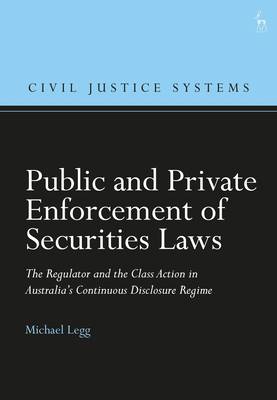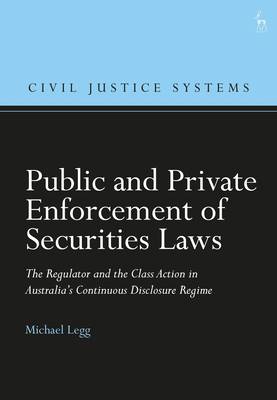
Je cadeautjes zeker op tijd in huis hebben voor de feestdagen? Kom langs in onze winkels en vind het perfecte geschenk!
- Afhalen na 1 uur in een winkel met voorraad
- Gratis thuislevering in België vanaf € 30
- Ruim aanbod met 7 miljoen producten
Je cadeautjes zeker op tijd in huis hebben voor de feestdagen? Kom langs in onze winkels en vind het perfecte geschenk!
- Afhalen na 1 uur in een winkel met voorraad
- Gratis thuislevering in België vanaf € 30
- Ruim aanbod met 7 miljoen producten
Zoeken
Public and Private Enforcement of Securities Laws
The Regulator and the Class Action in Australia's Continuous Disclosure Regime
Michael Legg
€ 99,95
+ 199 punten
Uitvoering
Omschrijving
This book undertakes unique case studies, including interviews with participants, as well as empirical analysis, of public and private enforcement of Australian securities laws addressing continuous disclosure.
Enforcement of laws is crucial to effective regulation. Historically, enforcement was the province of a government regulator with significant discretion (public enforcement). However, more and more citizens are being expected to take action themselves (private enforcement). Consistent with regulatory pluralism, public and private enforcement exist in parallel, with the capacity to both help and hinder each other, and the achievement of the goals of enforcement in a range of areas of regulation.
The rise of the shareholder class action in Australia, backed by litigation funding or lawyers, has given rise to enforcement overlapping with that of the government regulator, the Australian Securities and Investments Commission. The ramifications of overlapping enforcement are explained based on detailed analysis. The analysis is further bolstered by the regulator's approach to enforcement changing from a compliance orientation to a "Why not litigate?" approach.
The analysis and ramifications of the Australian case studies involve matters of regulatory theory and practice that apply across jurisdictions. The book will appeal to practitioners, regulators and academics interested in regulatory policy and enforcement, and the operation of regulators and class actions, including their interaction.
Enforcement of laws is crucial to effective regulation. Historically, enforcement was the province of a government regulator with significant discretion (public enforcement). However, more and more citizens are being expected to take action themselves (private enforcement). Consistent with regulatory pluralism, public and private enforcement exist in parallel, with the capacity to both help and hinder each other, and the achievement of the goals of enforcement in a range of areas of regulation.
The rise of the shareholder class action in Australia, backed by litigation funding or lawyers, has given rise to enforcement overlapping with that of the government regulator, the Australian Securities and Investments Commission. The ramifications of overlapping enforcement are explained based on detailed analysis. The analysis is further bolstered by the regulator's approach to enforcement changing from a compliance orientation to a "Why not litigate?" approach.
The analysis and ramifications of the Australian case studies involve matters of regulatory theory and practice that apply across jurisdictions. The book will appeal to practitioners, regulators and academics interested in regulatory policy and enforcement, and the operation of regulators and class actions, including their interaction.
Specificaties
Betrokkenen
- Auteur(s):
- Uitgeverij:
Inhoud
- Aantal bladzijden:
- 336
- Taal:
- Engels
- Reeks:
Eigenschappen
- Productcode (EAN):
- 9781509956784
- Verschijningsdatum:
- 15/06/2023
- Uitvoering:
- Paperback
- Formaat:
- Trade paperback (VS)
- Afmetingen:
- 170 mm x 244 mm
- Gewicht:
- 498 g

Alleen bij Standaard Boekhandel
+ 199 punten op je klantenkaart van Standaard Boekhandel
Beoordelingen
We publiceren alleen reviews die voldoen aan de voorwaarden voor reviews. Bekijk onze voorwaarden voor reviews.









